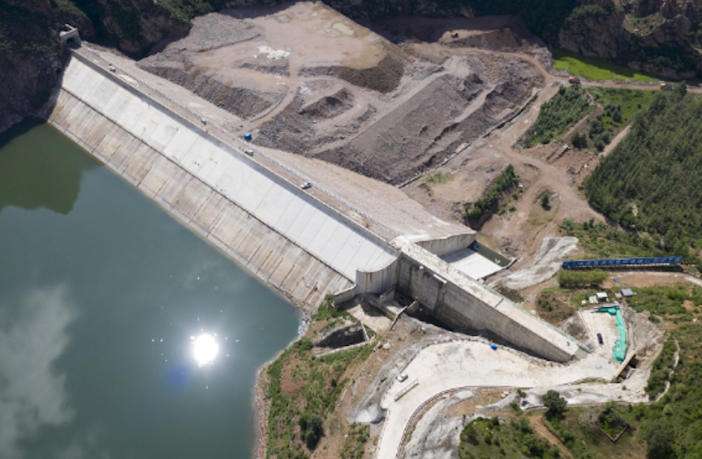- Phase 1 (1.8GW) of the 3.6GW in north China’s Hebei Province, believed to be the largest of its kind in the world, started operations yesterday.
- The massive pumped storage facility is being developed in two phases of 1.8GW capacity each by State Grid Xinyuan Company, a directly managed subsidiary of state-owned State Grid Corporation of China (SGCC).
- Phase two scheduled for commissioning in 2023.
- The station features a seamless switch between electric, solar, wind, and water potential energy.
Construction on the £2.1bn ($2.7bn) project has been underway since June 2013. It will have a total installed capacity of 3.6 gigawatts and annual designed generating capacity of 6.612 billion kilowatt-hours.
The hydropower station will provide green electricity to the power grid covering Beijing, Tianjing and the northern part of Hebei Province. Together with other pumped storage power facilities constructed earlier, it is expected to enhance the peak regulation capacity of the Beijing-Tianjin-Hebei power grid and the region’s wind power load regulation. And, the project will help to guarantee the power supply to the upcoming 2022 Beijing Winter Olympics.
“The pumped storage plant can help save 480,000 tonnes of coal and reduce 1.2 million tonnes of carbon dioxide emissions every year,” Wu Peizhi, deputy general manager of the power station, told China Media Group in June. “It will help make the Olympics 100-percent the greenest ever in history.”
To achieve carbon emission reduction, developing new sources of energy, such as wind and solar, and adjusting the energy structure are among the priorities. The Fengning pumped storage power station fits the goal.
China is putting efforts to expand its pumped hydro energy storage over the next decade, aiming to have 62 gigawatts of storage facilities operating by 2025, and 120 gigawatts by 2030, according to a plan published by the Chinese National Energy Administration in September.
Author: Bryan Groenendaal
Project Fast Facts
Location and site details
- The Fengning pumped storage project is located approximately 145km northwest of Chengde, in Fengning Manchu Autonomous County, Hebei, China.
- The project site lies approximately 180km from Beijing which will host the 2022 Winter Olympics.
- The upper reservoir for the project is located at Huiyaozigou on the left bank of the Luanhe River that flows northwards from Hebei to Inner Mongolia. It has a total storage capacity of 48.83m3.
- The pumped storage facility will use the existing Fengning hydropower facility near Niuyuan that was brought into operation in 2001 as the lower reservoir, which has a total storage capacity of 66.15m3.
Fengning pumped-storage project background
- A pumped storage hydropower facility at Fengning was conceived in 1996, while site selection and pre-feasibility study were completed in 2001.
- A feasibility study for the 3.6GW project was completed in 2009, which was approved by China’s National Development and Reform Commission (NDRC) in 2010.
- NDRC granted approval for the construction and operation of the Fengning pumped storage facility in 2012.
Plant make-up
- The Fengning pumped storage hydroelectric facility will comprise an underground powerhouse equipped with 12 reversible Francis pump-turbine units of 300MW capacity each.
- The project is being developed in two phases involving six reversible pump-turbine units each.
- Two of the six units to be installed in phase two will be variable-speed motor-generator units. Each variable speed pump-turbine unit will have a rated capacity of 330MVA in generator mode and 345MVA in pump mode.
- Fengning will be the first hydroelectric facility in China to integrate variable speed technology for efficient power generation.
Fengning pumped storage operation
- Water from the lower reservoir will be pumped uphill to the upper reservoir for storage utilising excess renewable energy present in the grid. The facility will use up to 4.565TWh of electricity a year for pumping operation.
- Stored water will be released downhill from the upper reservoir for power generation during peak electricity demand. The facility can switch from pumping mode to generate electricity at full capacity in just five minutes.
- The Fengning pumped storage power plant will be capable of generating 3.424TWh of electricity annually.
Power evacuation
- The electricity generated by the 3.6GW pumped-storage hydropower facility will be evacuated into the Beijing-Tianjin-North Hebei grid through two 500kV transmission lines.
Contractors involved with the Fengning pumped storage power project
- State-owned China Gezhouba Group (CGGC) was awarded the main construction contract for the Fengning pumped-storage hydropower station in April 2014.
- Andritz was contracted to supply two variable speed pump turbines along with AC-excitation, governor, as well as protection and computer control systems for phase two of the Fengning pumped-storage project in September 2017.
- Dongfang Electric Machinery is the provider of remaining pump-turbine units for the facility.
- In June 2018, GE Power was contracted to provide two variable speed MV7000 converters for the two pump-turbine units being supplied by Andritz, as well as one static frequency converter for the remaining four generators being supplied by Dongfang Electric Machinery.
- HBIS Group was contracted by Andritz to deliver 300t of extra-thick steel plates for the base ring boards of two reversible pump turbines for the project in 2018.
- HBIS also supplied 5000t of special hydropower steel products for the project previously.
- China Hydropower Engineering Consulting Group and Beijing Survey and Design Institute prepared the feasibility study report in 2009 while Beijing Guodian Hydropower Engineering prepared the pre-feasibility study report for the project.















